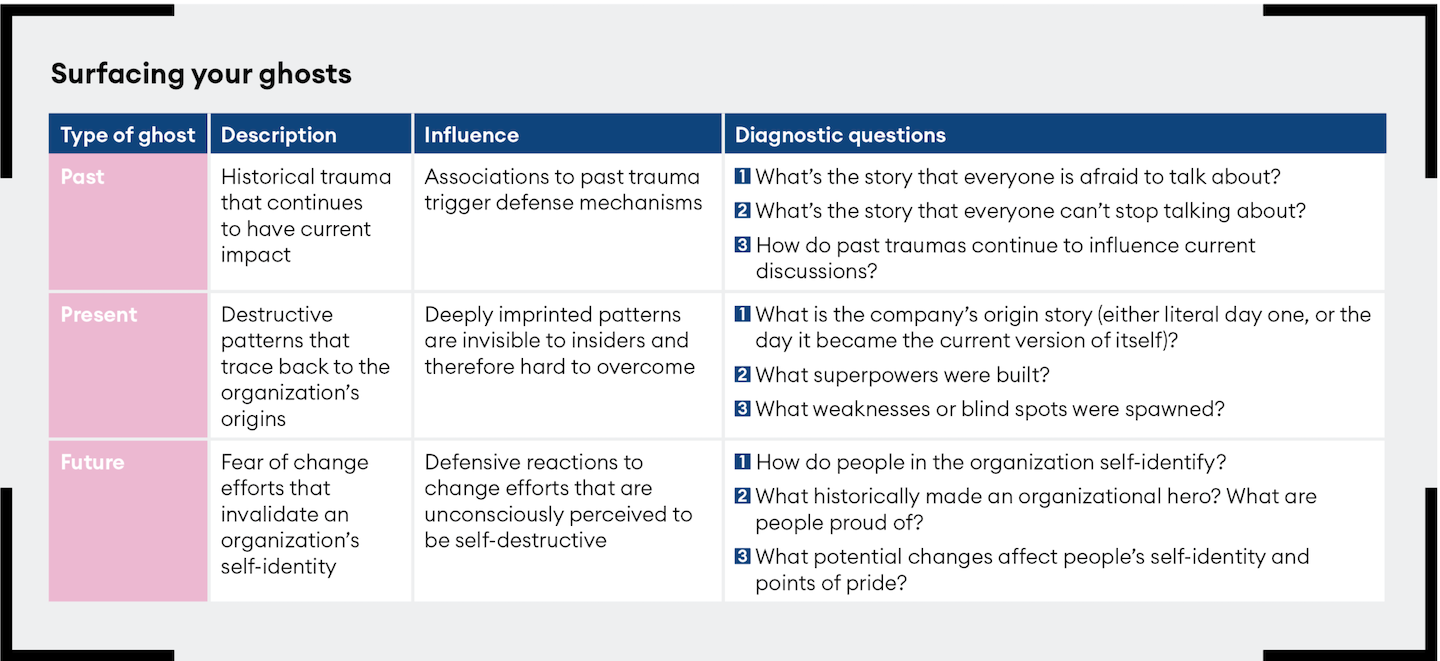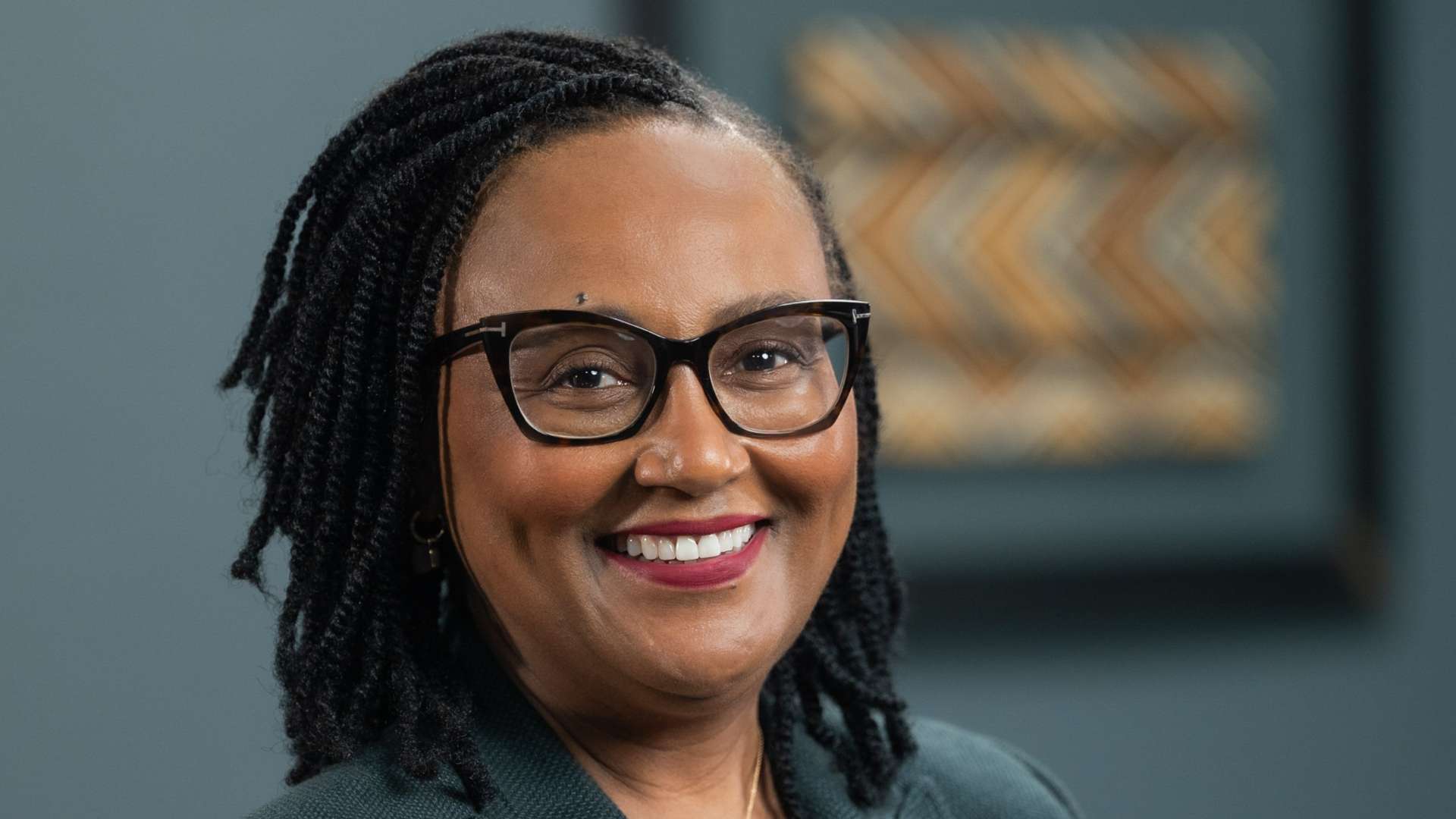Why do change programs keep falling short of their intended aims? Because organizations are haunted by ghosts.
What blocks change efforts in organizations from succeeding?
The usual suspects are a lack of time, misaligned incentives, inadequate skills or insufficient tools. Those things all are real, but our experience suggests that there is almost always something deeper going on, and it is something that few organizations have done the work to address: ghosts.
Yes, ghosts. Phantoms. Spirits. Shadows. Invisible but present. Ethereal but powerful forces that inhibit change in material ways. When it comes to organizational change, there are three specific types of ghosts. Ghosts of the past relate to unresolved trauma from past crises. Ghosts of the present are recurring patterns that trace back to the organization’s early days. And ghosts of the future are underlying fears that change will invalidate an organization’s self-identity. How do those ghosts affect change initiatives – and what can leaders do to counteract their effects?

“Not again” – ghosts of the past
“People keep disappearing,” Leanne said. “And no one ever talks about it publicly.” Leanne was a leader within a global medical device company tasked with boosting the company’s creativity and agility. While the company had grown substantially over the past two decades, like any business, it had gone through ups and downs. Whenever growth stalled, the company predictably started a headcount reduction program. Historically, such programs had been hastily pulled together and executed with minimal communications.
Losing a job is traumatic for an individual, of course, but those who watch a colleague suddenly disappear can also find the experience traumatic, especially if decisions feel random. Why them and not me? Might I be next? “A lot of people are scared of making mistakes,” one person told us. “I feel punished if I try to empower myself and exercise initiative,” said another. “It’s, ‘Let’s not take any risks – let’s just do the same, safest thing, whatever that is,’” said a third. Imagine Leanne then trying to get people to adopt new behaviors. Doing anything different requires going through a period of uncomfortable struggle, and no one wanted to be someone who looked like they were struggling at layoff time. People presented a range of rational reasons for why they didn’t have the time or the proper incentives for Leanne’s effort, but the root of the challenge was that her change program connected to past trauma, leading people to unconsciously shy away from it.
In the book The Uninvited Guest from the Unremembered Past: An Exploration of the Unconscious Transmission of Trauma Across the Generations, Prophecy Coles used a psychoanalytical lens to argue that past traumas caused by events ranging from wars to inter-sibling rivalries carry unconsciously through generations. Emerging research reinforces Coles’s view. Scientists have found that stress can alter the DNA of mice, leading to it impacting future generations.
Ghosts of the past – traumatic events like mass firings, exogenous shocks like the Covid-19 pandemic, major failures such as AT&T’s $100 billion write-down related to failed acquisitions of DirecTV and Time Warner, or scandals like accounting mis-statements or ethical lapses – need to be exorcised. Consider using Airbnb’s routine, ‘Elephants, Dead Fish and Vomit.’ Elephants refer to big things that no one dares to bring up. Dead fish are past issues that still affect the organization. And vomit refers to issues people just need to get off their chest. Ritualistically discussing these topics helps to keep ghosts of the past in the past.
“It’s just who we are” – ghosts of the present
We were in the middle of an Innosight leadership team meeting discussing how to strengthen our sales pipeline. A simple proposal emerged: every week have at least two conversations with people in your network. Straightforward enough. However, our conversation took a too-familiar turn from the practical to the abstract. We debated how to robustly measure our reach. We considered building a more rigorous business development framework for deeper root-cause analysis. The discussion was fast-paced and stimulating. It also was highly theoretical. And it led to vague conclusions and unclear next steps.
A seemingly simple answer quickly becoming overcomplicated, leading to inaction: everyone at Innosight has a version of this story, because we’ve been doing it since the day we were founded. By an academic (Harvard’s Clayton Christensen) who devoted his life to finding ways to frame problems.
Every organization has an origin story. It might literally be the moment of creation. It might be when it emerges out of the crucible of a crisis with clarity about its future direction. Just like comic book superheroes, the origin story creates superpowers. For Innosight, that is an insatiable curiosity that has led to a demonstrated capability around tackling complex, interdependent problems. The origin story, however, also spawns a ghost.
When ducks are born, they famously follow whatever they see first. Similarly, in 1965 Arthur Stinchcombe identified how organizations “absorb” pieces of their founding environment, and those elements remain remarkably persistent influences, even years down the line. A 2015 meta-study of imprinting by Christopher Marquis from Harvard and András Tilcsik from the University of Toronto detailed how a founder’s characteristics are reflected in an organization well beyond their participation in the business, and how “everything and everyone we study carry with them elements of the past”.
Imprinted behavior is largely invisible to an organization. Ask why it happens and the natural response is “that’s just the way things are done around here”. So, ghosts of the present need to be addressed with a tool we call a Bean, an acronym that stands for behavior enabler, artifact, and nudge.
Ripped from the habit-change literature, a Bean fights a two-front battle against invisible behavior. Behavior enablers like checklists, guides and formal rituals target the part of our brain that acts slowly and carefully. Artifacts and nudges like visual reminders, and gamification tools like leaderboards go after the part of our brain that acts without conscious thought. Airbnb’s exorcism ritual actually doubles as an inertia-busting Bean. (We have collated 100 additional Beans to encourage behavior change, at http://tiny.cc/101BEANs – use them to counteract the ghosts of the present.)
“I am God” – ghosts of the future
Hospitals are transforming from competing on healthcare (treating and managing illness, injuries and disease) to competing on health (wellness and prevention). It is a profound shift, one that requires doctors to fundamentally change with whom they interact and how they act. And it runs straight into a powerful ghost of the future.
In the movie Malice, Alec Baldwin plays a brilliant but cavalier surgeon who faces a malpractice suit. The lawyers tell him he is accused of having a God complex. His response? “You ask me if I have a God complex? Let me tell you something. I am God.”
Exaggerated for entertainment purposes? For sure. However, the hero ethic is well-researched in healthcare and medical education. “The culture of medicine – and the wider culture of society – elevates the status of the highly-skilled, expert physician, like a celebrity athlete or performer with unique abilities,” notes the 2022 book How Covid Crashed the System by David Nash and Charles Wohlforth.
As the industry shifts to compete on health, doctors play new roles in integrated care teams that may also involve nutritionists and yoga instructors. Meanwhile, insurers and governments are tightening control. What is the heroic doctor’s place in this new way of doing things? Doctors suffered through medical school. They had hopes and aspirations for their role in society. A doctor’s identity is tied to being the sage and the savior – and that is threatened by change.
Transformation summons ghosts of the future. While the effort might promise a better future for the organization as a whole, the formula for success changes, which means there are winners and losers. The perception of a shift from revered to irrelevant naturally triggers defense mechanisms. As Brené Brown of the University of Houston notes, “The number one cause of shame at work is fear of irrelevance. The number one cause of fear of irrelevance is change.”
Ghosts of the future need to be tackled head on. First, make the hidden fear of change explicit. Acknowledge the challenge and create space and time for people to process it. Then, seek to turn fear into excitement by developing a credible story for the individual benefits of the change and investing in training to help with inevitable struggles that accompany the change journey.
“I ain’t afraid of no ghost” – creating opportunities for change
The persistent finding that two-thirds of major change efforts fail leads some to conclude that the change management toolkit – clear vision, consistent communication, leader role modeling, quick wins, and so on – is lacking. Our perspective is that the toolkit is robust. The real challenge is that people aim solid tools at the wrong problem. Changing an organization is complex. If you don’t understand and address the ghosts of the past, present and future, the journey becomes harder, if not impossible. Be willing to enter a space where you can safely discuss uncomfortable topics. Wait long enough to discuss your ghosts and you will find that creative stories turn into myths that become hard to shake.
Change requires commitment. If you’ve run your exorcism, built your Beans, created space and support for change and you are still encountering the same problems, it’s time to ask whether you have the proverbial right people on the bus. (Or, at a more extreme level, whether your house just happens to be on an ancient burial ground and you really need to move).
We suspect your family of origin has myths and legends. We suspect it also has skeletons and destructive patterns. You grew up in a society that has some form of collective trauma, perhaps even an extreme one such as war, famine, genocide, or deeply rooted racial strife. Your organization may lack bonds of blood and hopefully has been spared an extreme trauma, but it has its own rich, shared history, which unconsciously affects individual and collective behavior. Your biggest barrier to change is likely not to sit visible in the sunlight. Rather, it lurks in the shadows – a present, persistent ghost that absorbs or counteracts the energy of your change efforts.
Bring your ghosts into the light. See them for what they are. Banish them. Counteract them. Do that, and you create the opportunity for your change efforts to flourish.
Scott D Anthony is a professor at Tuck School of Business, Dartmouth College, and senior partner at Innosight. Kristen Colella is a partner, Emily Ottman is associate partner and Andrew Waldeck is global managing partner at Innosight.



